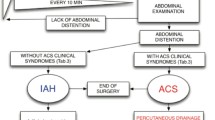Abstract
Purpose
This study was aimed to investigate incidence, circumstances and consequences of acute compartment syndrome (CS) of the lower extremity after gynecological operations in lithotomy position by collecting data from departments of Obstetrics and Gynecology in Germany.
Design
Retrospective observational study.
Setting
Departments of Obstetrics and Gynecology in the area of North Rhine (Germany)
Methods
A 24-item questionnaire was sent to 168 gynecological departments. In addition, cases anonymously reported to the Expert Committee for Medical Malpractice Claims of the Medical Association of North Rhine between 2002 and 2012 were analyzed.
Main outcome measure
Incidence of acute CS after gynecological operations.
Results
A total of 59 questionnaires (35 %) were returned for analysis, reporting 21 cases of CS. Based on the collected data, we calculated an incidence of postoperative CS ranging between 0.067 % and 0.28 %. All reported cases of postoperative CS occurred after surgeries in lithotomy position, 57.1 % of cases occurred after laparoscopic procedures and 76.2 % after procedures longer than 4 h. Overall, 61.0 % of departments do not routinely inform about the risk of this complication when they get patients’ informed consent. Reported prevention strategies were inconsistent and ranged from none to multiple measures.
Conclusion
CS is a complication clearly associated with long lasting gynecological operations in Lithotomy position. Despite a relatively high incidence, so far no guidelines on perioperative management and medicolegal aspects exist and preventive measures are heterogeneous among institutions. The need for guidelines and recommendations by an expert committee has been identified.

Similar content being viewed by others
Abbreviations
- AEKNO:
-
Medical Association of North Rhine
- BMI:
-
Body mass index
- CS:
-
Compartment syndrome
- ICP:
-
Intra-compartmental pressure
- LAP:
-
Laparotomy
- LSC:
-
Laparoscopy
- LT:
-
Lithotomy
- Ob&Gyn:
-
Obstetrics and Gynecology
- WLCS:
-
Well leg compartment syndrome
References
Pearse MF, Harry L, Nanchahal J (2002) Acute compartment syndrome of the leg. BMJ 325:557–558
Matsen FA, Krugmire RB (1978) Compartmental syndromes. Surg Gynecol Obstet 147:943–949
McQueen MM, Gaston P, Court-Brown CM (2000) Acute compartment syndrome. Who is at risk? J Bone Joint Surg BR 82:200–203
Beraldo S, Dodds SR (2006) Lower limb acute compartment syndrome after colorectal surgery in prolonged lithotomy position. Dis Colon Rectum 49:1772–1780
Boesgaard-Kjer DH, Boesgaard-Kjer D, Kjer JJ (2013) Well-leg compartment syndrome after gynecological laparoscopic surgery. Acta Obstet Gynecol Scand 92:598–600
Wassenaar EB, Van den Brand JG, Van der Werken C (2006) Compartment syndrome of the lower leg after surgery in the modified lithotomy position: report of seven cases. Dis Colon Rectum 49:1449–1453
Finkelstein JA, Hunter GA, Hu RW (1996) Lower limb compartment syndrome: course after delayed fasciotomy. J Trauma 40:342–344
Simms MS, Terry TR (2005) Well leg compartment syndrome after pelvic and perineal surgery in the lithotomy position. Postgrad Med J 81:534–536
Halliwill JR, Hewitt SA, Joyner MJ, Warner MA (1998) Effect of various lithotomy positions on lower-extremity blood pressure. Anesthesiology 89:1373–1376
Tomassetti C, Meuleman C, Vanacker B, D’Hooghe T (2038) Lower limb compartment syndrome as a complication of laparoscopic laser surgery for severe endometriosis. Fertil Steril 2009(92):e9–e12
Schofield PF, Grace RH (2004) Acute compartment syndrome of the legs after colorectal surgery. Colorectal Dis 6:285–287
Chase J, Harford F, Pinzur MS, Zussman M (2000) Intraoperative lower extremity compartment pressures in lithotomy-positioned patients. Dis Colon Rectum 43:678–680
Martin JT (1992) Compartment syndromes: concepts and perspectives for the anesthesiologist. Anesth Analg 75:275–283
Pfeffer SD, Halliwill JR, Warner MA (2001) Effects of lithotomy position and external compression on lower leg muscle compartment pressure. Anesthesiology 95:632–636
Peters P, Baker SR, Leopold PW, Taub NA, Burnand KG (1994) Compartment syndrome following prolonged pelvic surgery. Br J Surg 81:1128–1131
Meyer RS, White KK, Smith JM, Groppo ER, Mubarak SJ, Hargens AR (2002) Intramuscular and blood pressures in legs positioned in the hemilithotomy position: clarification of risk factors for well-leg compartment syndrome. J Bone Joint Surg Am 84:1829–1835
Tan V, Pepe MD, Glaser DL, Seldes RM, Heppenstall RB, Esterhai JL (2000) Well-leg compartment pressures during hemilithotomy position for fracture fixation. J Orthop Trauma 14:157–161
Kubiak R, Wilcox D, Spitz L, Kiely EM (1998) Neurovascular morbidity from the lithotomy position. J Pediatr Surg 33:1808–1810
MacIntosh EL, Blanchard RJ (1991) Compartment syndrome after surgery in the lithotomy position. Can J Surg 34:359–362
Scott JR, Daneker G, Lumsden AB (1997) Prevention of compartment syndrome associated with dorsal lithotomy position. Am Surg 63:801–806
Cohen SA, Hurt WG (2001) Compartment syndrome associated with lithotomy position and intermittent compression stockings. Obstet Gynecol 97:832–833
Montgomery CJ, Ready LB (1991) Epidural opioid analgesia does not obscure diagnosis of compartment syndrome resulting from prolonged lithotomy position. Anesthesiology 75:541–543
Johnson DJ, Chalkiadis GA (2009) Does epidural analgesia delay the diagnosis of lower limb compartment syndrome in children? Paediatr Anaesth 19:83–91
Mar GJ, Barrington MJ, McGuirk BR (2009) Acute compartment syndrome of the lower limb and the effect of postoperative analgesia on diagnosis. Br J Anaesth 102:3–11
Karmaniolou I, Staikou C (2010) Compartment syndrome as a complication of the lithotomy position. West Indian Med J 59:698–701
Shadgan B, Menon M, Sanders D et al (2010) Current thinking about acute compartment syndrome of the lower extremity. Can J Surg 53:329–334
Bhattacharyya T, Vrahas MS (2004) The medical–legal aspects of compartment syndrome. J Bone Joint Surg Am 86:864–868
Acknowledgments
We thank Dr. Weber from the Medical association North Rhine (AEKNO) for her support.
Conflicts of interest
None.
Author information
Authors and Affiliations
Corresponding author
Rights and permissions
About this article
Cite this article
Bauer, E.C.A., Koch, N., Erichsen, C.J. et al. Survey of compartment syndrome of the lower extremity after gynecological operations. Langenbecks Arch Surg 399, 343–348 (2014). https://doi.org/10.1007/s00423-014-1172-z
Received:
Accepted:
Published:
Issue Date:
DOI: https://doi.org/10.1007/s00423-014-1172-z




